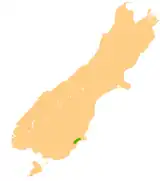



The Taieri Plain (also referred to in the plural as the Taieri Plains) is an area of fertile agricultural land to the southwest of Dunedin, in Otago, New Zealand. The plain covers an area of some 300 square kilometres, with a maximum extent of 30 kilometres. It is not to be confused with Strath Taieri, a second plain of the Taieri River, 40kms to the north beyond Mount Ross.
The floodplain of the Taieri and Waipori Rivers, the plain is enclosed to the west by Maungatua and the Silverpeaks Range, and to the south and east by a low range of coastal hills.[1]
Dairy and sheep farming dominate the agriculture of the plain, although deer farming is starting to have an economic impact. The alluvial nature of the land means that floods are not uncommon, especially in the area around the confluence of the two rivers. Stopbanks protect farmland, houses and Dunedin International Airport at Momona. State Highway 1 crosses parts of the plain along some of the stopbanks, with the result that this stretch of road is known locally as The "Floodfree" Highway.[2][3]
New Zealand's lowest point, at 2m below sea level, is slightly north of the airport on Kirk's Drain Road, Momona.
To the northeast, the city of Dunedin is separated from the Taieri Plain by a range of rugged hills which are part of the crater of an extinct volcano. At the northeastern limit of the plain lies the town of Mosgiel, officially part of the city of Dunedin. Other settlements and towns on the plain include Outram, Henley, Allanton, and Momona.
To the southwest, a short stretch of rolling hill country separates the Taieri Plain from South Otago's other main lowland areas around the Tokomairaro River and Clutha River.[1] The twin lakes of Waihola and Waipori sit within these hills, as does the Sinclair Wetlands Reserve.
References
- 1 2 Dowling, P. (ed.) (2004). ’’Reed New Zealand atlas’’. Auckland: Reed Publishing. Map 103. ISBN 0 7900 0952 8
- ↑ "Farming on the Flood free," Farmers Weekly, 3 February 2014. Retrieved 7 May 2018.
- ↑ Sherwood, S., McNeilly, H., and Dally, J., "Henley: The Otago township that became an island", stuff.co.nz, 24 July 2017. Retrieved 7 May 2018.
Further reading
- Shaw, M. S., and Farrant, E. D. (1949) The Taieri Plain: Tales of years that are gone. Dunedin: Otago Centennial Historical Publications.